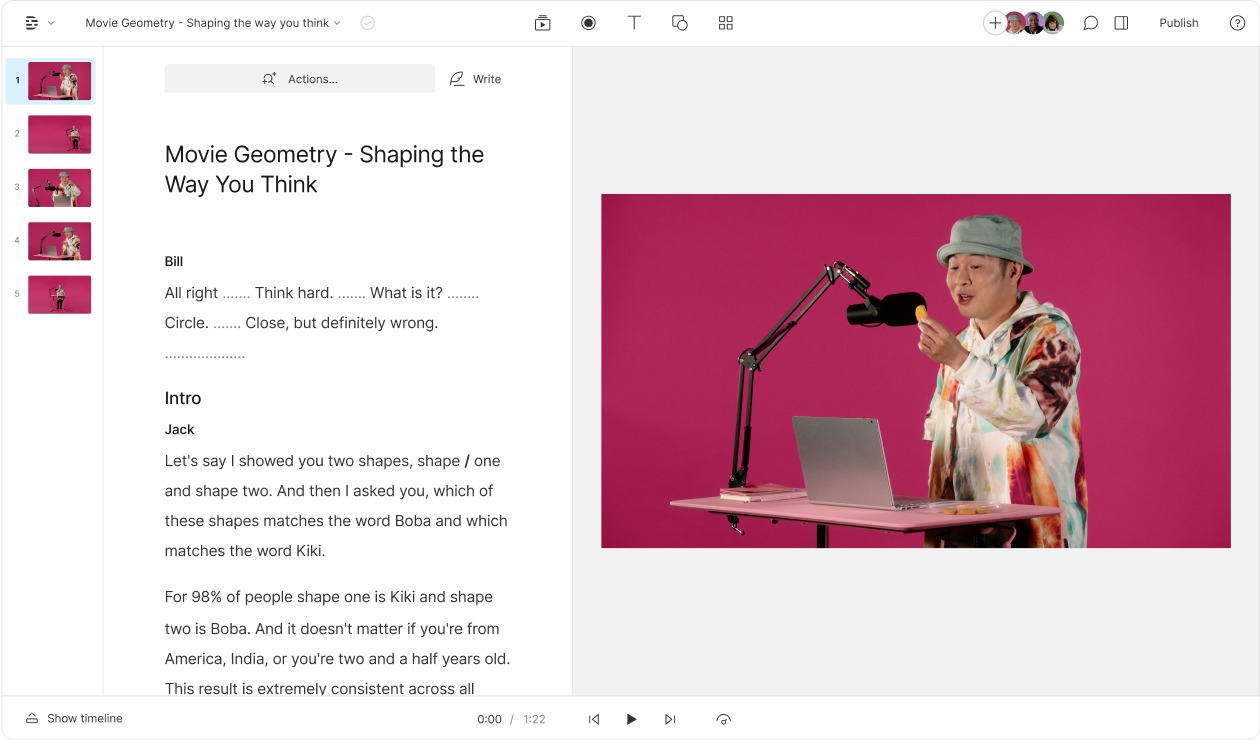What type of content do you primarily create?




When you make presentations, you probably spend most of your time deciding on fonts, arrangements, and images. Heck, maybe you’ve spent 30 minutes just aligning and adjusting objects on a single PowerPoint slide. We’ve all been there.
Obviously, these are important for a compelling presentation, but to really take your project to the next level, you’ll want to add music. Not only does music make presentations more fun, but it can also set a specific mood so your message gets through in the right way and sticks in people’s minds.
Luckily, Google Slides makes inserting audio files into your presentation as painless as possible.
This tutorial explores the benefits of including audio in a presentation and how to add music to Google Slides to make your content shine.
3 benefits of adding audio to Google Slides
Audio works wonders in a presentation. Here’s an overview of some of the top benefits.
Enhanced engagement
Adding the right audio clip to your presentation sets the tone for your audience, piquing their interest and even hinting at what information you’ll share.
Take Apple, for example. The company is well known for using excellent music and video presentations that captivate its audience, keeping them engaged to the end. In one of its WWDC keynotes, Vera Carr, Apple’s Special Projects Group director, played upbeat music to showcase the improved Workout app.
Clarification and emphasis
You want your audience to focus on your words and your slides. A complex topic, for example, might be hard to explain without media elements.
Audio can capture your audience's attention and spark interest, so they don't get bored reading text-heavy slides. Moreover, listening requires less effort than reading, making your content easier to understand.
Emotional impact
Studies show that music affects how we perceive the world and how we form memories. Adding music, sounds, and voices to a presentation can evoke different emotions, making it more immersive, lively, or appealing for your audience.
For example, upbeat music can shift the atmosphere to be more optimistic and exciting, while slower, gentle background music makes your audience more contemplative.
Next, let’s look at a few different ways you can add music to Google Slides.
How to add music to Google Slides: 4 ways
Whether you’re preparing for a large conference or just a one-on-one sales pitch, you can add audio elements like background music, voiceovers, or sound effects to give your presentation a little extra oomph.
Here are four different methods for adding audio files to Google Slides.
Insert audio from Google Drive
When adding music to Google Slides, you need to upload the file to Google Drive before inserting it into your slide deck.
Step 1: Prepare your music file
You can use your own audio in a presentation or pick royalty-free audio tracks from sites like Pixabay, YouTube Audio Library, or the Free Music Archive.
Step 2: Upload and save the audio file to Google Drive
Next, sign in to your Google Drive account, then select New (+) at the top left side of your My Drive screen.
|
Choose File upload.
|
Find your audio file and select Open. Your file should start uploading to Google Drive.
|
Step 3: Share your audio file
Once the audio file is uploaded to Google Drive, right-click the file then select Share > Share.
|
⚡TIP: If your mouse’s right-click function is disabled or not working, you can either select the file then click on the Share icon, or select the file, click on the ellipsis (three dots) on the right and select Share > Share.
Change the access settings from Restricted to Anyone with the link.
|
Set the sharing permissions to Viewer.
|
Select Done.
Step 4: Add the audio file to Google Slides
Go to Google Slides and select an existing presentation or select New (+) to create one.
|
Select the slide you want to add the audio file to then choose Insert > Audio from the toolbar.
|
Choose your audio file from your Google Drive, then select Insert.
|
A speaker icon will appear on the slide you selected along with a menu with formatting options on the right-hand sidebar. Here, you can choose whether the audio will play on click or automatically, increase or reduce the volume level, or change the icon color, and more.
|
Click on the audio playback icon to play the file or drag it wherever you want it to appear on the slide.
TIP: If you want your audio to play continuously across multiple slides, open the Format options panel and expand Audio playback. Uncheck Stop on slide change so the music keeps playing seamlessly throughout your presentation.
Hiding the speaker icon: If you don’t want the speaker icon cluttering your slide, right-click it and select Format options. In Audio playback, select Hide icon when presenting. Your slides will look cleaner while the music still plays in the background.
Insert audio from a URL
You can also add music to Google Slides using a URL or link to the file’s location on the web or streaming services like SoundCloud, YouTube Music, Apple Music, or Spotify, though this method is pretty cumbersome.
Note: For this guide, we’ll insert music using a link or URL from a SoundCloud file. Make sure you’re connected to the internet to play the audio during your presentation.
Here’s how to make a slideshow with music:
Step 1: Find the soundtrack to use
Open SoundCloud in a browser window and find the page with the soundtrack you want to use. Before using the file, check to make sure it’s not copyrighted, it has a Creative Commons license, and/or it’s public domain content.
|
Step 2: Select Copy Link to copy the soundtrack URL
|
Step 3: Insert the URL in your Google Slides presentation
Select the slide you want to add the URL or link to, then choose Insert in the menu bar.
|
Select Link.
|
Paste the link in the blank link text box then select Apply.
|
Select Slideshow to test whether the audio file will play during your presentation.
|
Click on the area containing the link. It will open in a new browser tab or window with the page you picked the audio file from. Select the Play button then minimize the browser to return to your presentation.
|
To stop the audio, go back to the web page and click on the Pause or Stop button.
Record narration
Most slide presentations consist of chunks of disconnected text in bullet points. Without additional explanations, your audience might not make sense of the presentation.
Adding narration to the presentation strengthens your message. It also:
Allows you to provide instructions or emphasize key points
Makes it a standalone resource that people can view any time
Makes it more accessible to different members of your audience
Creates a different mood in your audience
Changes the pace or tone of your presentation
Boosts viewers’ ability to absorb and retain the content better
Here’s how to add narration to Google Slides.
Step 1: Record your narration
Record your narration before adding it to your presentation. A quick way to do this is using Descript’s voice recorder, which lets you record your voice with studio-quality sound and save or export it as an MP3, AAC, or WAV file.
|
Step 2: Upload and share the file on Google Drive
Repeat the steps for uploading an audio file to Google Drive. Then share the file, setting the access permissions to “Anyone with the link can be a viewer.”
Step 3: Add the narration to Google Slides
Select the slide you want to add your narration to then select Insert > Audio. You’ll see a speaker icon on the slide indicating the audio has been added to your presentation.
|
Step 4: Preview your presentation
Select Slideshow to preview your slide in presentation mode and test whether the narration plays as it should.
|
Use YouTube videos with audio
Another way to add audio to your Google Slides presentation is to embed a YouTube video. Note that some video owners copyright their YouTube content, so you can’t share it via Google Slides.
Step 1: Open YouTube and find the video to use
Open YouTube and play the video, noting the start and end time timestamps for the section you want to add to your presentation. You can also create a video and upload it to your YouTube channel, then add its URL to Google Slides.
|
⚡TIP: Descript’s YouTube video editor can help you set the portion of the video you want by adjusting the text in the generated transcript—just like editing a Word document.
Step 2: Copy the YouTube video link
Select Share or copy the link to the YouTube video.
|
Step 3: Add the link to your Google Slides presentation
Open your presentation in Google Slides, select the slide that will play the file, then select Insert > Video.
|
Select YouTube then paste the YouTube video link you copied earlier.
|
Next, select the video and click Insert.
|
A thumbnail preview of the YouTube video will appear on the slide. You can hide the video behind a picture or resize it and move it to a new location in your presentation.
|
Note: Google Slides updated the playback options for videos. By default, the video will play on click as you go through your presentation. You can change the playback mode using the “Video playback” drop-down settings to autoplay when presenting.
|
Elevate your Google Slides with Descript
Descript is an all-in-one, AI-powered tool for creating and editing audio and video files.
You can create an audio recording and add transitions like fade in, fade out, or crossfade. Alternatively, you can extract audio from other audio files or record yourself while screen sharing your slides to create a slideshow video.
Descript also enhances voice recordings with AI, leaving you with ready-to-edit audio you can use in a presentation or podcast. The software automatically transcribes your audio, then identifies and removes annoying filler words so your recordings sound rehearsed.
You’ll save tons of time and create quality presentations that leave a lasting impression.
FAQs
How do you add Spotify songs to Google Slides?
You can add Spotify songs to Google Slides by copying and inserting the link to the song you want to add to your presentation. However, Spotify doesn’t play songs in a presentation like your local audio file would. Instead, it will open the Spotify web or desktop app to play the song.
How do you add music from Apple Music to Google Slides?
To add an Apple Music track to Google Slides, copy the song link, then insert it into a slide in your presentation. The song will open in the Apple Music web-based player. In some cases, it will play a preview of the audio file, depending on your location, whether you’re signed in to your account, or whether you’re using the web player and desktop app concurrently.
What audio file formats are supported in Google Slides?
How do I make music play automatically on Google Slides?
Insert your audio or video, then select it and open Format options (or Video playback). Choose Autoplay when presenting or Play automatically. This setting lets the music start by itself when you reach that slide.
How do I add music from YouTube to Google Slides?
The easiest way is to insert a YouTube video. Choose Insert > Video and paste the YouTube link. Position or resize the video so it’s unobtrusive, and set playback options to Autoplay if you want it to start automatically.
Why can't I add audio to Google Slides?
Make sure you’re using an acceptable file format (MP3 or WAV) and that your file is shared correctly in Google Drive. Also, check that you’re an editor or owner of the presentation. If you still have trouble, try clearing your browser’s cache or using a different browser to see if that fixes the issue.
How do I add background music to Google Slides so it plays across multiple slides?
You can add background music by inserting an audio file from Google Drive into your first slide. In the Format options, turn off Stop on slide change so the music continues when you move to the next slide. Just be sure your audio file is shared so viewers have permission to hear it.
Google Slides supports WAV and MP3 files. If you’re struggling to add audio, make sure your file is saved in one of these formats and that it’s shared so others can access it.
























































%201.svg)












